这篇文章主要为大家展示了“python机器学习Sklearn中adaboost算法的示例分析”,内容简而易懂,条理清晰,希望能够帮助大家解决疑惑,下面让小编带领大家一起研究并学习一下“python机器学习Sklearn中adaboost算法的示例分析”这篇文章吧。
pandas批量处理体测成绩
import numpy as npimport pandas as pdfrom pandas import Series,DataFrameimport matplotlib.pyplot as pltdata = pd.read_excel("/Users/zhucan/Desktop/18级高一体测成绩汇总.xls")cond = data["班级"] != "班级"data = data[cond] data.fillna(0,inplace=True)data.isnull().any() #没有空数据了结果:
班级 False
性别 False
姓名 False
1000米 False
50米 False
跳远 False
体前屈 False
引体 False
肺活量 False
身高 False
体重 False
dtype: bool
data.head()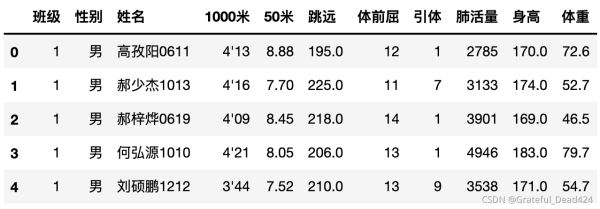
#1000米成绩有string 有intdef convert(x): if isinstance(x,str): minute,second = x.split("'") int(minute) minute = int(minute) second = int(second) return minute + second/100.0 else: return xdata["1000米"] = data["1000米"].map(convert)
score = pd.read_excel("/Users/zhucan/Desktop/体侧成绩评分表.xls",header=[0,1])score
def convert(item): m,s = item.strip('"').split("'") m,s =int(m),int(s) return m+s/100.0score.iloc[:,-4] = score.iloc[:,-4].map(convert) def convert(item): m,s = item.strip('"').split("'") m,s =int(m),int(s) return m+s/100.0 score.iloc[:,-2] = score.iloc[:,-2].map(convert)score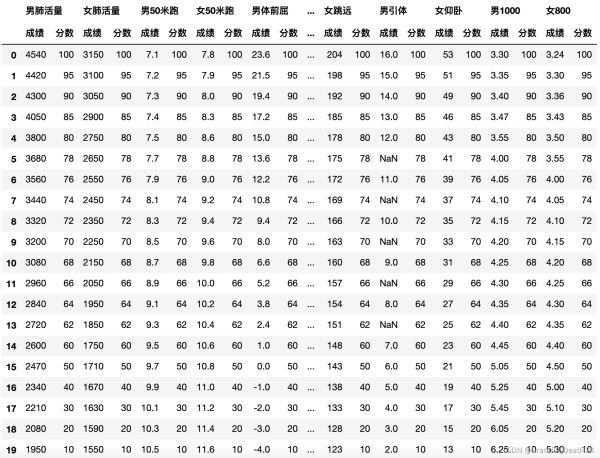
data.columns = ['班级', '性别', '姓名', '男1000', '男50米跑', '跳远', '体前屈', '引体', '肺活量', '身高', '体重']data["男50米跑"] = data["男50米跑"].astype(np.float)for col in ["男1000","男50米跑"]: #获取成绩的标准 s = score[col] def convert(x): for i in range(len(s)): if x<=s["成绩"].iloc[0]: if x == 0: return 0 #没有参加这个项目 return 100 elif x>s["成绩"].iloc[-1]: return 0 #跑的太慢 elif (x>s["成绩"].iloc[i-1]) and (x<=s["成绩"].iloc[i]): return s["分数"].iloc[i] data[col + "成绩"] = data[col].map(convert)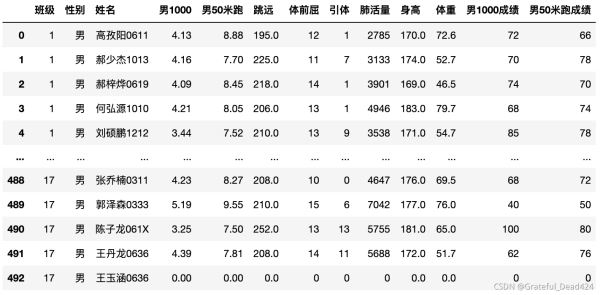
for col in ['跳远', '体前屈', '引体', '肺活量']: s = score["男"+col] def convert(x): for i in range(len(s)): if x>s["成绩"].iloc[i]: return s["分数"].iloc[i] return 0 data[col+"成绩"] = data[col].map(convert)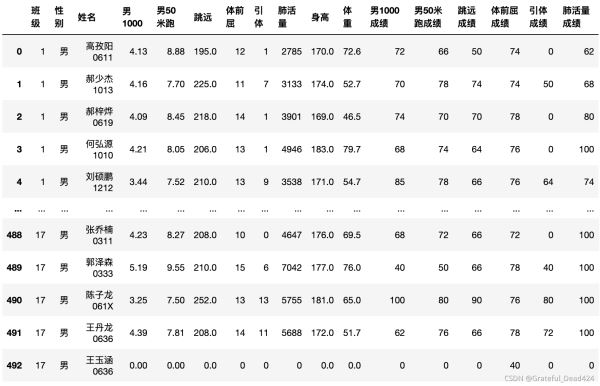
data.columns结果:
Index(['班级', '性别', '姓名', '男1000', '男50米跑', '跳远', '体前屈', '引体', '肺活量', '身高', '体重', '男1000成绩', '男50米跑成绩', '跳远成绩', '体前屈成绩', '引体成绩', '肺活量成绩'], dtype='object')#根据索引的顺序,去data取值cols = ['班级', '性别', '姓名', '男1000','男1000成绩','男50米跑','男50米跑成绩','跳远','跳远成绩','体前屈','体前屈成绩','引体','引体成绩', '肺活量','肺活量成绩','身高','体重']data[cols]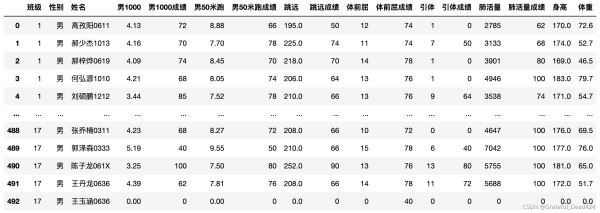
#计算BMIdata["BMI"] = data["体重"]/data["身高"]def convert(x): if x>100: return x/100 else: return xdata["身高"] = data["身高"].map(convert)data["BMI"] = data["体重"]/(data["身高"])**2def convert_bmi(x): if x >= 26.4: return 60 elif (x <= 16.4) or (x > 23.3 and x <= 26.3): return 80 elif x >= 16.5 and x <= 23.2: return 100 else: return 0data["BMI_score"] = data["BMI"].map(convert_bmi)#统计分析data["BMI_score"].value_counts().plot(kind = "pie",autopct = "%0.2f%%")#统计分析data["BMI_score"].value_counts().plot(kind = "bar")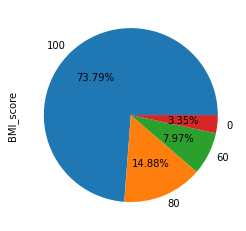
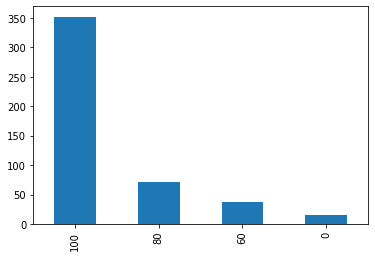
data.groupby(["男1000成绩"])["BMI_score"].count().plot(kind = "bar")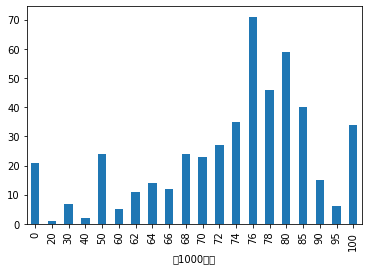
adaboost
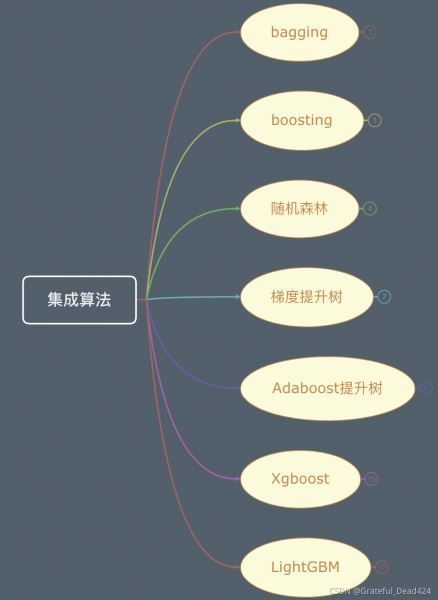

 值
值
越大,特征越明显,越被容易分开;越后面的学习器,权重越大
梯度提升树没有修改原来的数据,使用的是残差,最终结果就是最后一棵树
上面的图不是GBDT

Boosting与Bagging模型相比,Boosting可以同时降低偏差和方差,Bagging只能降低模型的方差。在实际应用中,Boosting算法也还是存在明显的高方差问题,也就是过拟合。
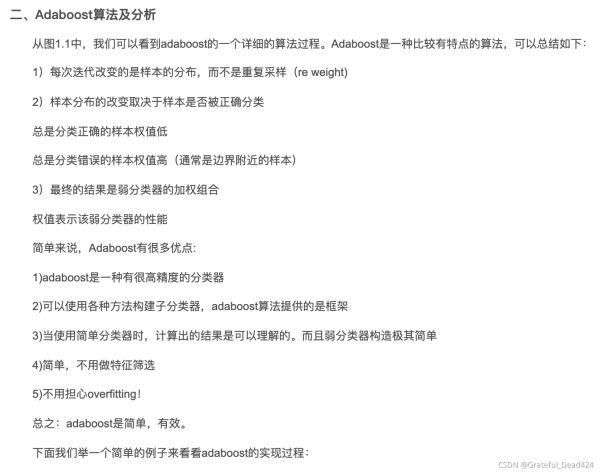

import numpy as npy = np.array([0,1]*5)y_ = np.array([0,0,0,0,0,0,0,1,0,1])w = 0.1*(y != y_).sum()round(w,1)结果:
0.3
0.5*np.log((1-0.3)/0.3)round((0.5*np.log((1-0.3)/0.3)),2)结果:
0.42
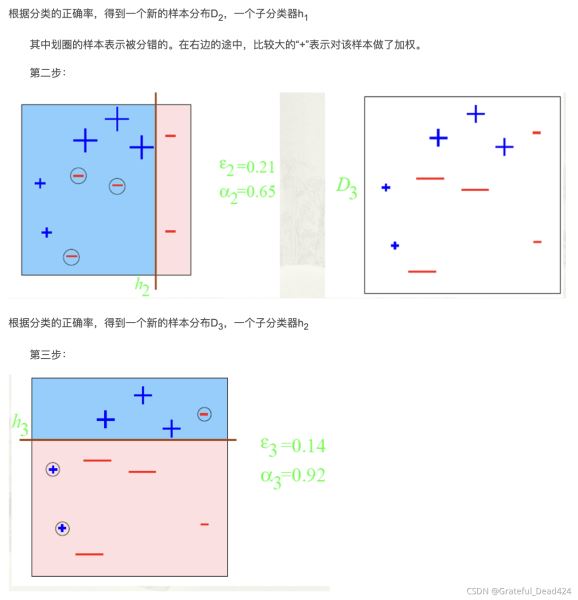
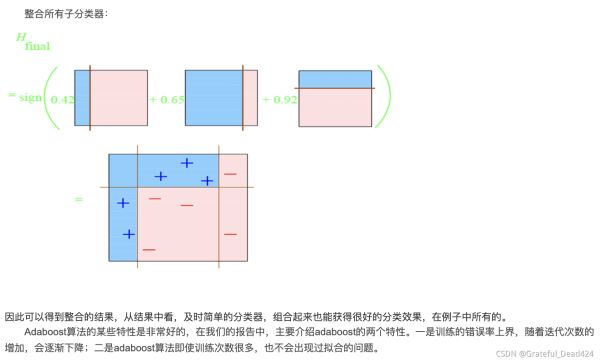
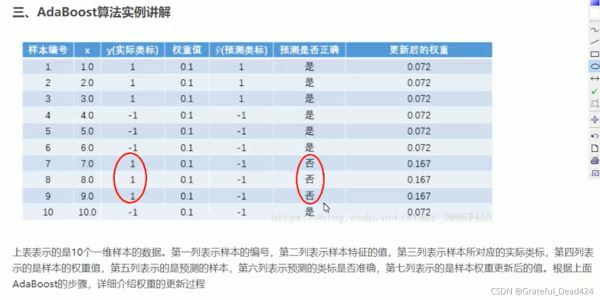
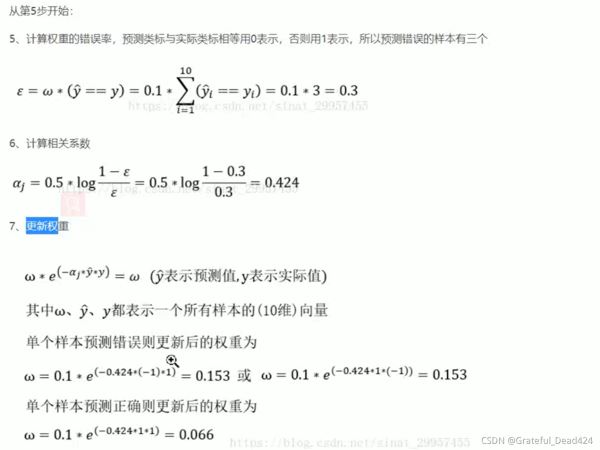
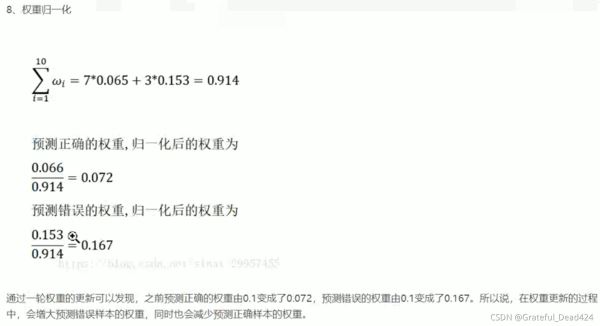


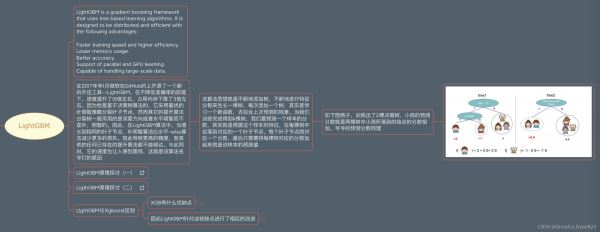

adaboost原理案例举例
from sklearn.ensemble import AdaBoostClassifierfrom sklearn import treeimport matplotlib.pyplot as pltX = np.arange(10).reshape(-1,1)y = np.array([1,1,1,-1,-1,-1,1,1,1,-1])ada = AdaBoostClassifier(n_estimators=3)ada.fit(X,y)plt.figure(figsize = (9,6))_ = tree.plot_tree(ada[0])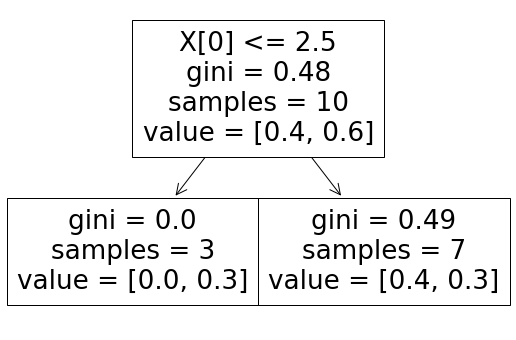
y_ = ada[0].predict(X),4y_结果:
array([ 1, 1, 1, -1, -1, -1, -1, -1, -1, -1])#误差率e1 = np.round(0.1*(y != y_).sum(),4)e1结果:
0.3
#计算第一棵树权重#随机森林中每棵树的权重是一样的#adaboost提升树中每棵树的权重不同a1 = np.round(1/2*np.log((1-e1)/e1),4)a1结果:
0.4236
#样本预测准确:更新的权重w2 = 0.1*np.e**(-a1*y*y_)w2 = w2/w2.sum()np.round(w2,4)结果:
array([0.0714, 0.0714, 0.0714, 0.0714, 0.0714, 0.0714, 0.1667, 0.1667, 0.1667, 0.0714])#样本预测准确:更新的权重w2 = 0.1*np.e**(-a1*y*y_)w2 = w2/w2.sum()np.round(w2,4)结果:
array([0.0714, 0.0714, 0.0714, 0.0714, 0.0714, 0.0714, 0.1667, 0.1667, 0.1667, 0.0714])从上述第一轮的整个迭代过程可以看出:被误分类样本的权值之和影响误差率,误差率影响基本分类器在最终分类器中所占的权重
分类函数 f1(x)= a1*G1(x)= 0.4236G1(x)
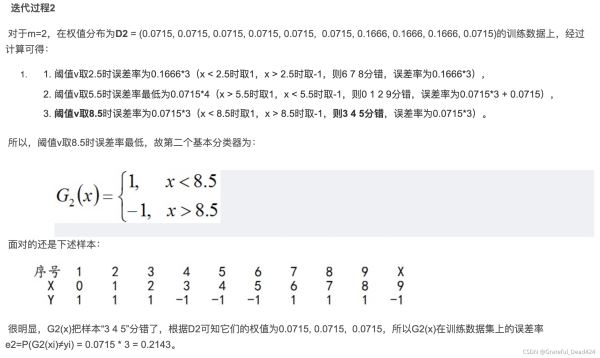
plt.figure(figsize = (9,6))_ = tree.plot_tree(ada[1])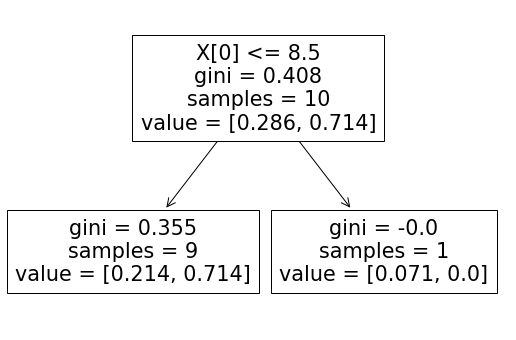
e2 = 0.0714*3e2结果:
0.2142
a2 = np.round(1/2*np.log((1-e2)/e2),4)a2结果:
0.6499
y_ = ada[1].predict(X)#样本预测准确:更新的权重w3 = w2*np.e**(-a2*y*y_)w3 = w3/w3.sum()np.round(w3,4)结果:
array([0.0454, 0.0454, 0.0454, 0.1667, 0.1667, 0.1667, 0.106 , 0.106 , 0.106 , 0.0454])plt.figure(figsize = (9,6))_ = tree.plot_tree(ada[2])
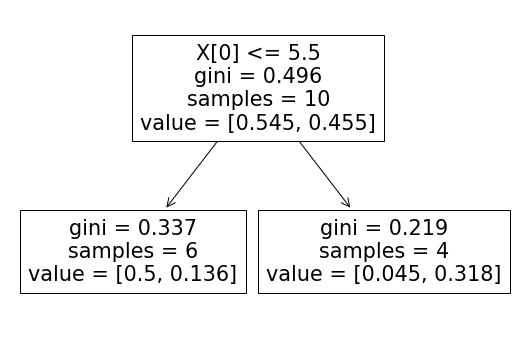
树划分按照gini系数;结果和按照误差率是一致的~
y_ = ada[2].predict(X)e3 = (w3*(y_ != y)).sum()a3 = 1/2*np.log((1-e3)/e3)a3#样本预测准确:更新的权重w4 = w3*np.e**(-a3*y*y_)w4 = w4/w4.sum()np.round(w4,4)结果:
array([0.125 , 0.125 , 0.125 , 0.1019, 0.1019, 0.1019, 0.0648, 0.0648, 0.0648, 0.125 ])display(a1,a2,a3)结果:
0.4236
0.6498960745553556
0.7521752700597043
弱分类器合并成强分类器
综上,将上面计算得到的a1、a2、a3各值代入G(x)中
G(x) = sign[f3(x)] = sign[ a1 * G1(x) + a2 * G2(x) + a3 * G3(x) ]
得到最终的分类器为:
G(x) = sign[f3(x)] = sign[ 0.4236G1(x) + 0.6496G2(x)+0.7514G3(x) ]
ada.predict(X)结果:
array([ 1, 1, 1, -1, -1, -1, 1, 1, 1, -1])y_predict = a1*ada[0].predict(X) + a2*ada[1].predict(X) +a3*ada[2].predict(X)y_predictnp.sign(y_predict).astype(np.int)array([ 1, 1, 1, -1, -1, -1, 1, 1, 1, -1])以上是“python机器学习Sklearn中adaboost算法的示例分析”这篇文章的所有内容,感谢各位的阅读!相信大家都有了一定的了解,希望分享的内容对大家有所帮助,如果还想学习更多知识,欢迎关注编程网行业资讯频道!




